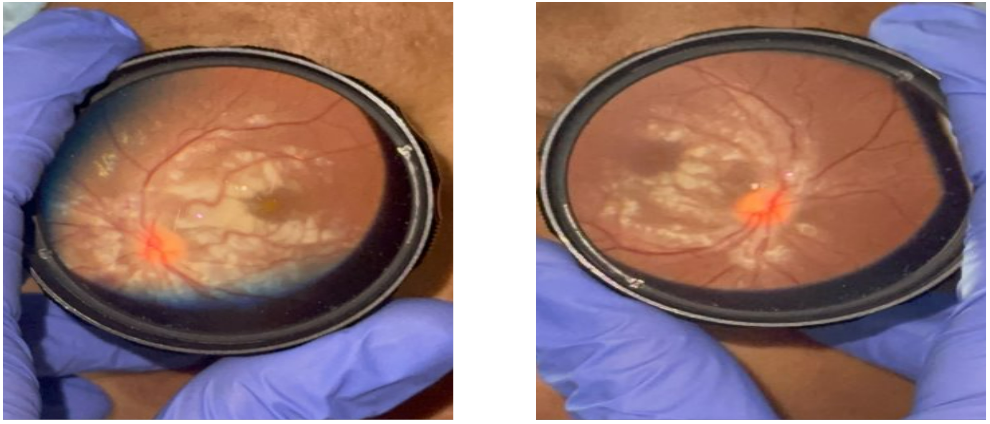Monday Poster Session
Category: Biliary/Pancreas
P2280 - Purtscher-Like Retinopathy as an Unusual Initial Manifestation of Acute Pancreatitis in a Postpartum Patient
Monday, October 27, 2025
10:30 AM - 4:00 PM PDT
Location: Exhibit Hall
- FD
Fnu Deepali, MD (she/her/hers)
Thomas Jefferson University
Philadelphia, PA
Presenting Author(s)
Fnu Deepali, MD1, Kevin Robinson, MBBS2, Karecia Byfield, MBBS3, Tinsae Anebo, MD4, Laith Alomari, MD1, Mikaela Nikkola Jara-Tantoco, MD5, Akshay Ratnani, DO5, Riley Marotta, DO5, Irhoboudu D. Atogwe, MD3, Michael Goldberg, DO4
1Thomas Jefferson University, Philadelphia, PA; 2Jefferson Einstein Philadelphia Hospital, Philadelphia, PA; 3Jefferson Einstein Hospital, Philadelphia, PA; 4Jefferson Einstein Hospital/Thomas Jefferson University, Philadelphia, PA; 5Albert Einstein Medical Center, Philadelphia, PA
Introduction: Purtscher-like retinopathy is a rare retinal microangiopathy typically associated with traumatic injuries or systemic conditions with complement activation, including acute and chronic pancreatitis. While most gastrointestinal pathologies present with abdominal symptoms, other symptoms may also give clues. We present a case of Purtscher-like retinopathy as the initial manifestation of acute pancreatitis in a postpartum patient.
Case Description/
Methods: 32-year-old female with a medical history of hypertension, class III obesity (BMI 40), and iron deficiency anemia presented at 33 weeks of gestation with elevated blood pressure. She was diagnosed with pre-eclampsia, for which she was started on labetalol and underwent an uncomplicated cesarean section. Postoperatively, she experienced mild abdominal pain. On postoperative day two, she developed bilateral blurred vision and headaches. CT head was unremarkable, but fundoscopic examination revealed multiple polygonal peripapillary retinal whitening areas (Purtscher flecken), prompting evaluation for systemic etiologies. Given the known association with pancreatitis, a serum lipase level was obtained and found to be elevated. CT abdomen confirmed acute interstitial pancreatitis. The patient was appropriately treated with intravenous fluids and supportive care. Her symptoms improved, and she was discharged in stable condition with outpatient follow-up
Discussion: Though uncommon, Purtscher-like retinopathy may serve as an important clinical clue for underlying systemic diseases such as acute pancreatitis, especially in patients with vague symptoms or overlapping peripartum complications. The pathogenesis is thought to involve complement activation and leukocyte embolization leading to retinal ischemia. In this case, the initial manifestation of pancreatitis was visual disturbances, which underscores the importance of a multidisciplinary approach in evaluating atypical presentations. Early identification and treatment of pancreatitis is critical to prevent severe complications.

Figure: Fundus photograph of the left and right eye with peripapillary retinal whitening consistent with Purtscher flecken.
Disclosures:
Fnu Deepali indicated no relevant financial relationships.
Kevin Robinson indicated no relevant financial relationships.
Karecia Byfield indicated no relevant financial relationships.
Tinsae Anebo indicated no relevant financial relationships.
Laith Alomari indicated no relevant financial relationships.
Mikaela Nikkola Jara-Tantoco indicated no relevant financial relationships.
Akshay Ratnani indicated no relevant financial relationships.
Riley Marotta indicated no relevant financial relationships.
Irhoboudu Atogwe indicated no relevant financial relationships.
Michael Goldberg indicated no relevant financial relationships.
Fnu Deepali, MD1, Kevin Robinson, MBBS2, Karecia Byfield, MBBS3, Tinsae Anebo, MD4, Laith Alomari, MD1, Mikaela Nikkola Jara-Tantoco, MD5, Akshay Ratnani, DO5, Riley Marotta, DO5, Irhoboudu D. Atogwe, MD3, Michael Goldberg, DO4. P2280 - Purtscher-Like Retinopathy as an Unusual Initial Manifestation of Acute Pancreatitis in a Postpartum Patient, ACG 2025 Annual Scientific Meeting Abstracts. Phoenix, AZ: American College of Gastroenterology.
1Thomas Jefferson University, Philadelphia, PA; 2Jefferson Einstein Philadelphia Hospital, Philadelphia, PA; 3Jefferson Einstein Hospital, Philadelphia, PA; 4Jefferson Einstein Hospital/Thomas Jefferson University, Philadelphia, PA; 5Albert Einstein Medical Center, Philadelphia, PA
Introduction: Purtscher-like retinopathy is a rare retinal microangiopathy typically associated with traumatic injuries or systemic conditions with complement activation, including acute and chronic pancreatitis. While most gastrointestinal pathologies present with abdominal symptoms, other symptoms may also give clues. We present a case of Purtscher-like retinopathy as the initial manifestation of acute pancreatitis in a postpartum patient.
Case Description/
Methods: 32-year-old female with a medical history of hypertension, class III obesity (BMI 40), and iron deficiency anemia presented at 33 weeks of gestation with elevated blood pressure. She was diagnosed with pre-eclampsia, for which she was started on labetalol and underwent an uncomplicated cesarean section. Postoperatively, she experienced mild abdominal pain. On postoperative day two, she developed bilateral blurred vision and headaches. CT head was unremarkable, but fundoscopic examination revealed multiple polygonal peripapillary retinal whitening areas (Purtscher flecken), prompting evaluation for systemic etiologies. Given the known association with pancreatitis, a serum lipase level was obtained and found to be elevated. CT abdomen confirmed acute interstitial pancreatitis. The patient was appropriately treated with intravenous fluids and supportive care. Her symptoms improved, and she was discharged in stable condition with outpatient follow-up
Discussion: Though uncommon, Purtscher-like retinopathy may serve as an important clinical clue for underlying systemic diseases such as acute pancreatitis, especially in patients with vague symptoms or overlapping peripartum complications. The pathogenesis is thought to involve complement activation and leukocyte embolization leading to retinal ischemia. In this case, the initial manifestation of pancreatitis was visual disturbances, which underscores the importance of a multidisciplinary approach in evaluating atypical presentations. Early identification and treatment of pancreatitis is critical to prevent severe complications.

Figure: Fundus photograph of the left and right eye with peripapillary retinal whitening consistent with Purtscher flecken.
Disclosures:
Fnu Deepali indicated no relevant financial relationships.
Kevin Robinson indicated no relevant financial relationships.
Karecia Byfield indicated no relevant financial relationships.
Tinsae Anebo indicated no relevant financial relationships.
Laith Alomari indicated no relevant financial relationships.
Mikaela Nikkola Jara-Tantoco indicated no relevant financial relationships.
Akshay Ratnani indicated no relevant financial relationships.
Riley Marotta indicated no relevant financial relationships.
Irhoboudu Atogwe indicated no relevant financial relationships.
Michael Goldberg indicated no relevant financial relationships.
Fnu Deepali, MD1, Kevin Robinson, MBBS2, Karecia Byfield, MBBS3, Tinsae Anebo, MD4, Laith Alomari, MD1, Mikaela Nikkola Jara-Tantoco, MD5, Akshay Ratnani, DO5, Riley Marotta, DO5, Irhoboudu D. Atogwe, MD3, Michael Goldberg, DO4. P2280 - Purtscher-Like Retinopathy as an Unusual Initial Manifestation of Acute Pancreatitis in a Postpartum Patient, ACG 2025 Annual Scientific Meeting Abstracts. Phoenix, AZ: American College of Gastroenterology.
